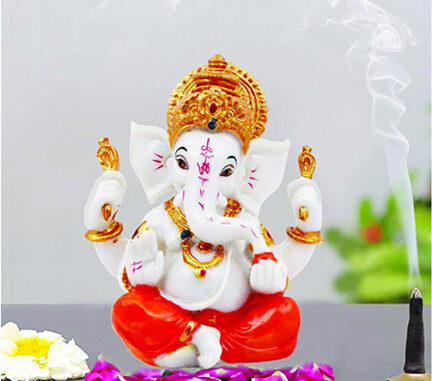
The festival of Ganesh Chaturthi is celebrated to honor the Hindu god Ganesh. The festival, also known as Vinayaka Chaturthi is observed in the Hindu calendar month of Bhaadrapada, starting on the shukla chaturthi (fourth day of the waxing moon period) and lasts for 10 days, ending on Anant Chaturdashi (fourteenth day of the waxing moon period). People start celebrations by preparing months in advance by making eco-friendly idols, artistic clay models of Lord Ganesha and decorating the idols. The size of these idols vary from inches to feet. Ganesh Chaturthi starts with the installation of these Ganesh statues in colorfully decorated homes and specially erected temporary structures mandapas (pandals) in many localites. The pandals are decorated using decorative items like flower garlands, lights, etc.. Some pandals are made theme based which depict religious themes, events related to Lord Ganesha or sometimes current events. The collective celebrations of Ganesha Chaturthi dates back to early 1890. At that time the society was divided on the basis of caste and relegious beliefs. LokManya Bal GangaDhar Tilak decided to bring the divided society into one thread and asked the people to come together and celebrate the festival in collective manners. During the celebrations, the chanting of mantras invokes the presence of Ganesha. This ritual is the Pranapratishhtha. After this, the ritual called as Shhodashopachara (16 ways of paying tribute) follows during which Coconut, jaggery, modaks, durva blades of grass and red flowers are offered. The statue of Lord Ganesha is anointed with red unguent, made of kumkum and sandalwood paste. The festival ends with Ganesha visarjana during which these installed statues of Lord ganesha are immersed into the water bodies sea and river.
Lord Ganesh is considered to be the God who has the ability to bestow wisdom and wealth upon humans. All the new undertakings, whether at place of work or at home, start by reciting the mantra of Lord Ganesha. He is known as the God of good luck and prosperity. Therefore, before any auspicious occasion, Hindus performs the puja of Lord Ganesha, to achieve success in it. Ganesh Chaturthi, the day marking the birth of the Lord, is celebrated in a grand manner in Maharashtra as well as other parts of India. It falls in the Hindu lunar month of Bhadra and lasts over a period of ten days. One of the most loving festivals of India, Ganesh Chaturthi has many legends associated with it. Given below are the legends from Shiv and Skanda Purana.
Legend From Shiv Purana
The most popular legend associated with Lord Ganesha can be found in the Shiv Purana. It says that Lord Ganapati was created out of the dough that Goddess Parvati used for her bath. The Goddess wanted a door-keeper, to prevent the coming of any visitors when she took a bath. So, she created a doll from the dough and breathed life into him. The day she did this came to be known as the birthday of Lord Ganesha, which we today celebrate as Ganesh Chaturthi. On day, while Goddess Parvati was taking her bath, Lord Shiva happened to visit her. Ganesha did not know him, so he did not allow the Lord to enter the house. This made Lord Shiva angry and he beheaded Ganesha. Later, when he came to know the truth, he fixed the head of an elephant in place of Ganesha’s head. With this, the appearance of Lord Ganesha changed and he came to have the head of an elephant.
Legend From Skanda Purana
There is yet another popular legend associated with Ganesh Chaturthi, arising from Skanda Purana. It goes that once Ganesha was invited for a feast in Chandralok. He ate many Ladoos and later, as he got up to walk after the meal, he could not balance himself, because of his huge stomach, and slipped. His stomach burst and all the laddoos came rolling out. Seeing this, the moon could not control himself and began laughing. Ganesha got angry and cursed the moon that it will vanish from the universe.
Because of moon’s absence, the whole world began to wane. The gods asked Lord Shiva to get Ganesha to change his mind. The moon also apologized for his misbehavior. Finally, Ganesha modified his curse saying that the moon would be invisible on only one day of a month and would be partially seen on Ganesha Chaturthi. He also added that anyone who watches moon on Ganesha Chaturthi would face a false accusation. This is the reason why, even today, it is considered inauspicious to look at the moon on Ganesh Chaturthi.
Law of worship
On this day, after bathing in the morning, an idol of Ganesha should be worshiped with gold, copper, silver, clay or cow dung. At the time of worship, we offer twenty-one Modakas and should offer twenty-one seedlings of Green Durva to the following ten names –
- Gatapi, 2. Ghori Suman, 3. Aghanashak, 4. Ekadanta, 5. Ishputra, 6. Sarvasiddhiprada, 7. Vinayaka, 8. Kumar Guru, 9. Inbhakkatraya, 10. Mooshak Vahan Sant.
After that, out of twenty-one laddus, ten laddus should be donated to Brahmins and eleven laddus should be eaten by themselves.
Katha
Godess Parvati created Ganesha out of sandalwood paste that she used for her bath and breathed life into the idol. She then set him to stand guard at her door while she bathed. When Lord Shiva returned from outside and as Ganesha didn’t know him, he didn’t allow Lord Shiva to enter. Lord Shiva became enraged and asked his follower Ganas to teach the child some manners. Ganesha being very powerful, defeated everyone and did not allow anyone to enter inside while his mother was taking bath. Finally angry Lord Shiva severed the head of the child Ganesha. After seeing this Godess Parvati became enraged and then Lord Shiva promised Her that the child will be alive again.
The ganas searched for the head of person in North direction, but they could not find and human and instead brought the head of an elephant. Lord Shiva fixed it on the child’s body and brought him back to life.





Be the first to comment